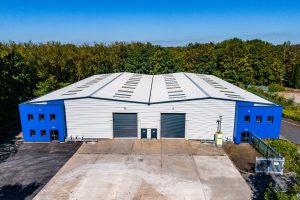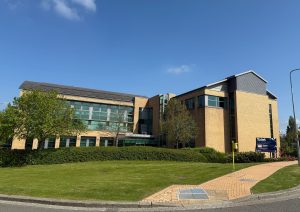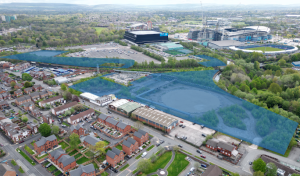What did civil engineers ever do for us?

Ahead of the Institution of Civil Engineers’ 200th birthday in 2018, TheBusinessdesk.com meets some of the North West engineers behind Britain’s infrastructure.
The Water engineer
Turning on the tap to fill the kettle, flushing the loo and washing our hands. Those are things we all do several times a day without having to think about it, and that’s thanks to water engineers like Kevin Harvey who have spent a career doing the thinking for us.
“I only wanted to be a draughtsman because I really enjoyed technical drawing, and things kind of grew from there,” admits Kevin, 52, who is now a chartered senior civil engineer at water company United Utilities.
Married with two children, Kevin is a Warringtonian born and bred, and did his OND and HND in Civil Engineering at Warrington College. He got his first insight into the world of pipes when he took a job with Bury Council doing work on behalf of North West Water.
Around this time, he was encouraged to start a part-time degree in Civil Engineering at Bolton Institute of Higher Education. Kevin recalls: “It was hard work. It took me five years to take the degree. For every day I was released to college I had to make up a half day with extra hours at work. But it was really valuable for me to be learning on the job.”
It was 1989, the year of water privatisation, when Kevin joined North West Water’s Engineering division. After decades of under-investment in water pipes and sewers the drive was on to meet the huge challenges set by new European environmental legislation. The River Mersey was the most polluted in Europe and only 20% of North West beaches met the minimum standards of water cleanliness. And so began a generation of water infrastructure projects on a scale not seen since Victorian times – and civil engineers would be at the heart of it.
“I was privileged to work on the later phases of the MEPAS project (Mersey Estuary Pollution Alleviation Scheme) which brought sewage treatment to Liverpool for the first time,” said Kevin.
It involved the construction of a 2.4m interceptor tunnel from Liverpool Airport in the south along the banks of the Mersey up to Crosby in the north, picking up 28 raw sewage outfalls along the route.
“I’m proud to this day that there are now fish, seals, even octopus in the Mersey,” he added.
Kevin has worked for a number of high profile engineering firms during his career, including Bechtel, MWH, and Black & Veatch, but always on projects for the water industry.
He continued: “We utilised a UU-developed technique called die drawing to re-line 30km of the Vyrnwy aqueduct. It involved using a force of around 100 tonnes to pull a larger diameter polyethylene pipe through a smaller diameter original cast iron pipe, stretching it out like an elastic band to reduce its diameter and then releasing the tension to make a snug fit. The specialised end restraint couplings we developed on the project were brand new in the industry.”
The project he is working on now is the biggest Kevin has ever been involved with; the £300m new West Cumbria Water Supply scheme which, for the first time, will link communities like Whitehaven and Workington to the rest of the North West’s integrated water supply system. It will guarantee a sustainable source of water for the West of Cumbria, where at present the existing local supply is prone to drought and its abstraction is putting a strain on the local ecology.
“We’re picking up where the Victorians left off,” he said. “They built the Thirlmere system which brings water by gravity to Manchester. We are now extending that system, using gravity to take water the other way from Thirlmere, north via Keswick, then across to the west coast.
“It’s a massive undertaking and there are interfaces with six different contractors. We’re building 29km of new aqueduct, a new water treatment works, 38km of new network main, two new underground service reservoirs, not mention re-lining a further 15km of existing pipework.
“There are five tunnels, one of which is 2.1km long. Each of these elements alone would constitute a major project.
“Then the environmental challenges are huge. The new pipeline will be going through the heart of the Lake District National Park.
“There are red squirrels, badgers, salmon and ancient woodland. And there’s the small matter of tourists. Engagement with stakeholders has been really interesting and an essential part of the design process. We’ve made a number of modifications to the route so that we can keep the environmental impact to an absolute minimum.”
Kevin has been involved with the scheme from design and he will be the technical lead throughout the delivery up to 2022. Getting the right suppliers has been key, including visits to Spain and Northern Ireland to see pipe manufacturers and welding techniques.
The scheme will incorporate the latest technology as part of United Utilities’ integrated systems thinking approach. Fibre-optic telemetry cable will be laid alongside the new pipelines to link automated valves and pressure monitors, sending real-time data to the company’s regional control centre. That will allow faster decisions to be taken in a more joined up way, improving efficiency and service to customers.
Kevin added: “The West Cumbria Scheme got off the ground in June and it will keep me busy for the next five years. Looking back, the water industry has been an exciting place to be a civil engineer over the last 25 years. I’m proud to be a part of it – to leave a legacy of cleaner rivers and more resilient water supplies for future generations.”

Water pipeline sections at Workington docks









